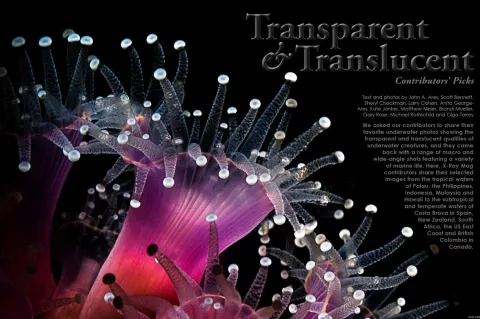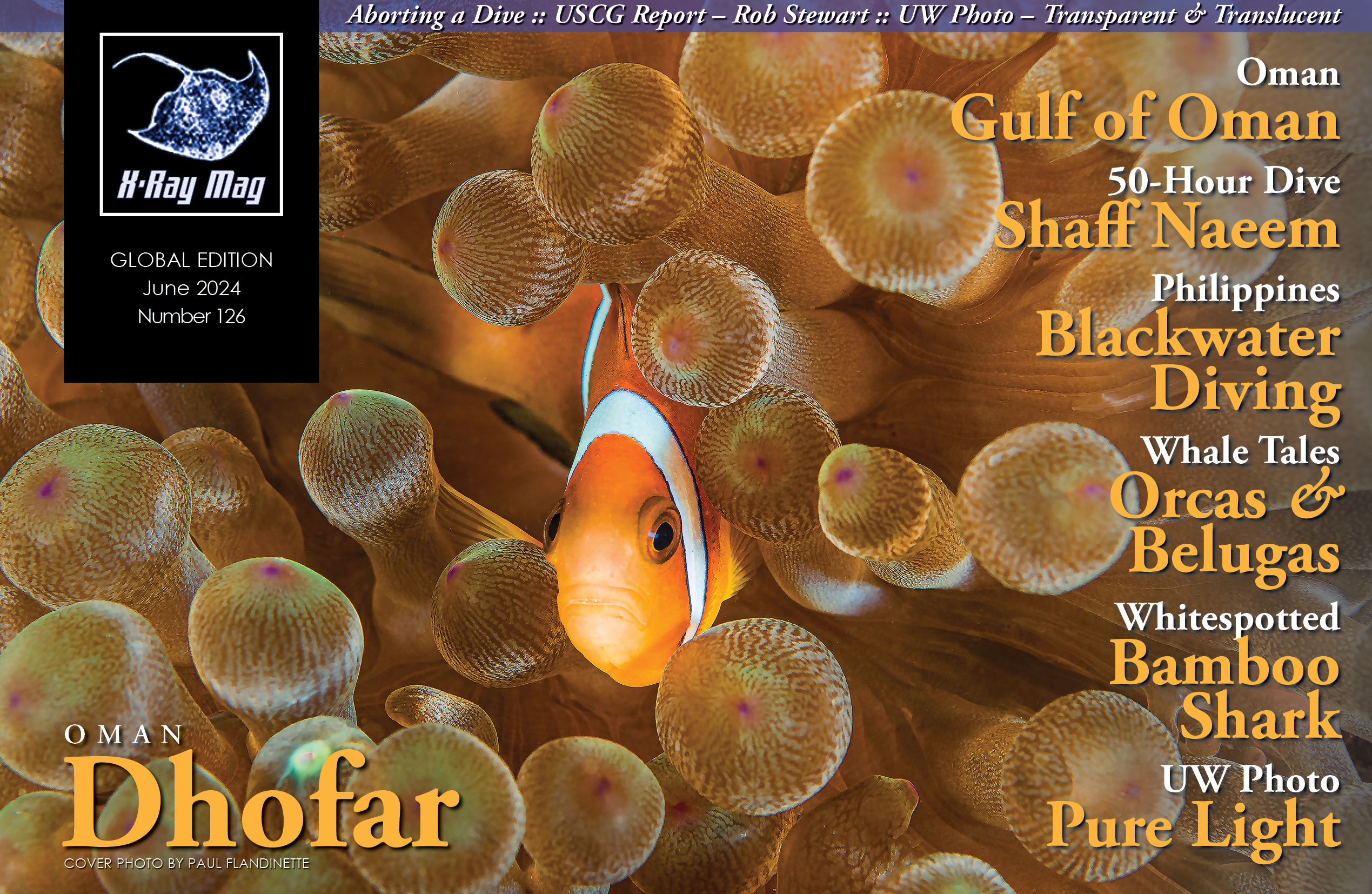We asked our contributors to share their favorite underwater photos showing the transparent and translucent qualities of underwater creatures, and they came back with a range of macro and wide-angle shots featuring a variety of marine life. Here, X-Ray Mag contributors share their selected images from the tropical waters of Palau, the Philippines, Indonesia, Malaysia and Hawaii to the subtropical and temperate waters of Costa Brava in Spain, New Zealand, South Africa, the US East Coast and British Columbia in Canada.
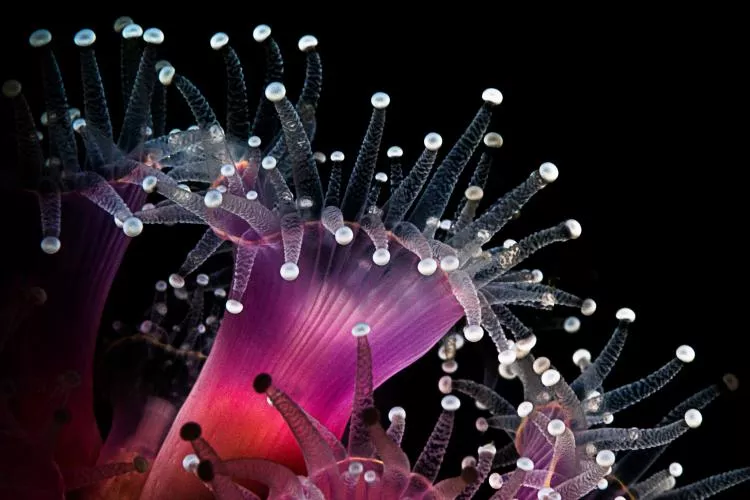
Contributed by
(To see all the images in the article, please scroll down to the end and download the pdf.)
Exploring Transparency & Translucency
Text and photos by Kate Jonker
Photographing transparent and translucent subjects underwater, using deliberate and directional lighting techniques, can reveal the beautiful and unusual characteristics of subjects, creating compelling and distinctive images. Transparency, where light passes through a subject without scattering, and translucency, where some light passes through but is diffused in the process, provide underwater photographers with unique opportunities to depict the underwater world in all its mesmerizing glory.
The transparency of subjects, such as the phantom nudibranch (Melibe colemani) and the ghost nudibranch (Melibe engeli), tiny cuttlefish eggs, and some butterfly sacoglossan sea slugs (Cyerce sp.), can be highlighted by careful light positioning.
Start by creating a black background with your camera settings. Then using inward strobe lighting (or a snoot positioned slightly behind your subjects and directed towards the camera) will allow light to pass through their bodies, rendering them transparent. Not only does this produce an intriguing effect, but it also enhances the detail of the subject against the black background of the water. On the other hand, translucent subjects such as the gasflame nudibranch (Bonisa nakaza) can be made to glow by using the same lighting technique.
Knowing which subjects to photograph in this way, and mastering these lighting techniques, empowers photographers to craft images that not only inspire wonder, but also evoke powerful emotions in the viewers of their underwater photos. Visit: katejonker.com
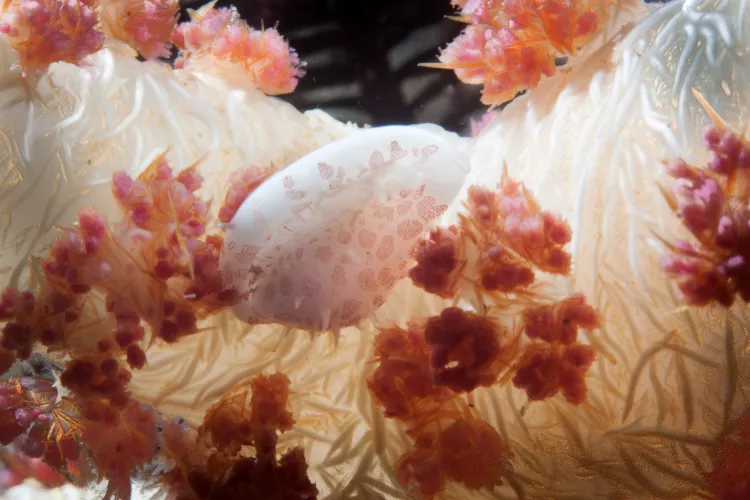
The Glowing Effect of Translucence
Text and photos by John Ares
Many underwater creatures are transparent or translucent, adding to their appeal. While transparent creatures allow a complete view through the body, translucent creatures allow only some light to pass through, creating a glowing effect.
The translucent soft coral in Photo 1 features a tiny soft coral cowry. It was perhaps half an inch long. Positioning the light behind the coral allowed a nice glow to appear within the coral.
Sea anemones are perfect subjects for translucency. The bubble-tip anemone in Photo 2 was backlit with two strobes above and off to each side.
The spotted jellyfish in Photo 3 has a mild sting and is not considered hazardous to humans. Gorgeous and translucent, this jellyfish was easy to photograph. It did not swim fast and did not have long tentacles to avoid.
Tunicates are part of the reward for diving slowly and carefully (Photo 4). They are easy to miss when making a high-speed patrol over a reef. Tunicates can be found as individuals or in colonies. Many tunicates are translucent, making them ideal for backlighting. Visit: JohnAres.com
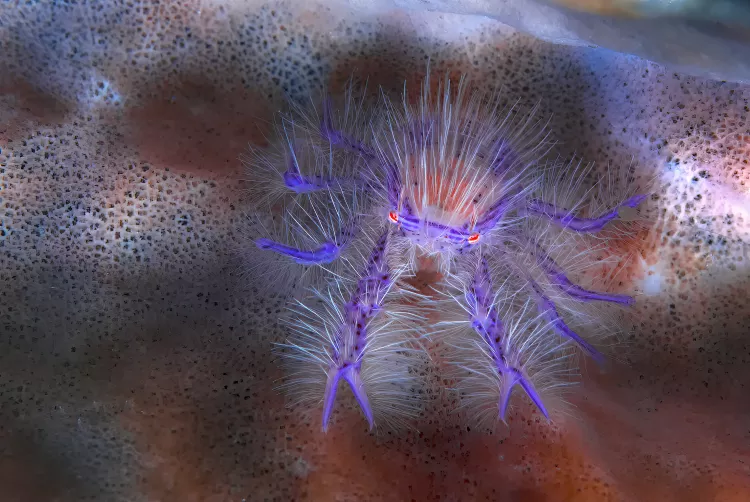
A Treasure Trove
Text and photos by Scott Bennett
Across the Indo-Pacific, commensal shrimp are commonly encountered residing among the tentacles of their anemone hosts. During a dive at Indonesia’s Lembeh Strait, I encountered a commensal shrimp uniquely draped over one of the tentacles. Advancing closer, I was able to photograph it straight on. Dotted with blue and white, its transparent body contrasted sharply with the muted tones of its host.
During a night dive on Indonesia’s Flores Island, I encountered a reef squid suspended less than a metre below the surface. Utterly unfazed by my presence, it allowed a close approach. A small aperture rendered the background dark, while my strobes revealed a translucent kaleidoscope of orange, yellow, magenta, blue and green. I managed to capture a few images before it leisurely retreated into the darkness.
For macro enthusiasts, Anilao in the Philippines boasts a treasure trove of unique and colourful critters at every turn. Measuring no more than 1.5 centimetres, hairy squat lobsters are virtually translucent, with pinkish-purple legs, purple spots and an abundance of white hairs. Close inspection of a giant barrel sponge revealed a specimen hiding inside, just beneath the rim. A small aperture ensured maximum depth of field, while strobes were carefully positioned to accent the white hairs.
With its unique fusion of temperate and sub-tropical species, New Zealand’s Poor Knights Islands features some of the best diving on the planet. Especially prolific are the tiny jewel anemones that adorn the walls with brilliant splashes of colour. Closer scrutiny reveals structures of extraordinary delicacy, with magenta patterns radiating out to the minute tentacles that encircle the rim. Visit: xray-mag.com/Contributors/Scott-Bennett
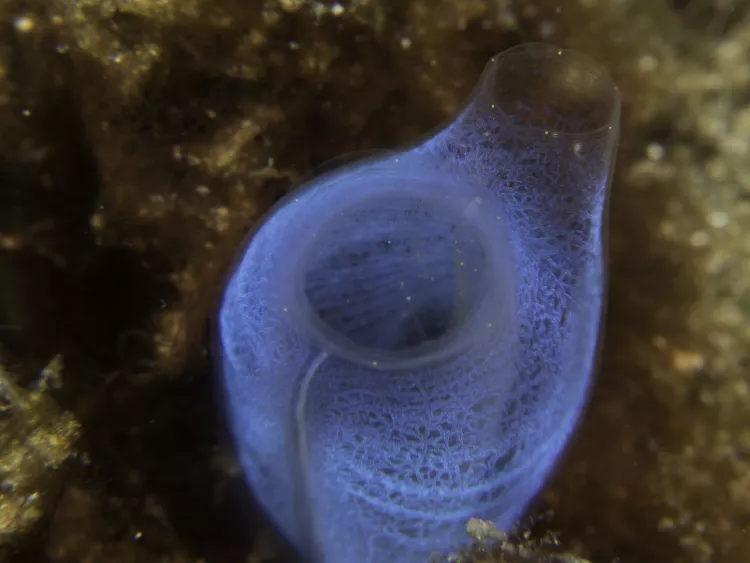
Hiding in Plain Sight
Text and photos by Sheryl Checkman
Transparency or translucency is when light passes through a subject, allowing you to see through it either clearly or with diffusion. Under the sea, there are many creatures that have one of these qualities. For some, this helps protect them from predators, by camouflaging them in their surroundings and allowing them to hide in plain sight. In all cases, however, this transparency or translucency adds just another dimension of beauty for us to behold.
In Alor, Indonesia, I photographed a blue club tunicate (also known as a sea squirt) at the Ampera dive site. Its electric blue translucence and circular shape give it the appearance of a glass vase or sculpture. These marine invertebrates spend most of their lives attached to a solid surface, like a vase sitting on a table just waiting for a floral (or coral) arrangement.
Sun corals (Tubastrea spp.) are translucent corals. I photographed this spectacular looking yellow-orange coral in Alor on a night dive at the house reef just off of our resort. This coral has translucent arms that remind me of a sunflower.
Another colorful yet translucent creature that I found in Alor at the Pasir Hitam dive site was the pink hairy squat lobster, also known as the fairy crab. This tiny crab has ten translucent legs with purple spots and white hairs coming out of its body. It lives in close proximity to giant barrel sponges.
At Jellyfish Lake on Eil Malk Island in Palau, I snorkeled with the millions of golden jellyfish that inhabit it. These see-through invertebrates get their nutrition from a symbiotic relationship with the algae that live in the lake. There is so much beauty underwater, some easily visible, and others, like these creatures, that require a closer look. Visit: Instagram.com/SherylCheckman
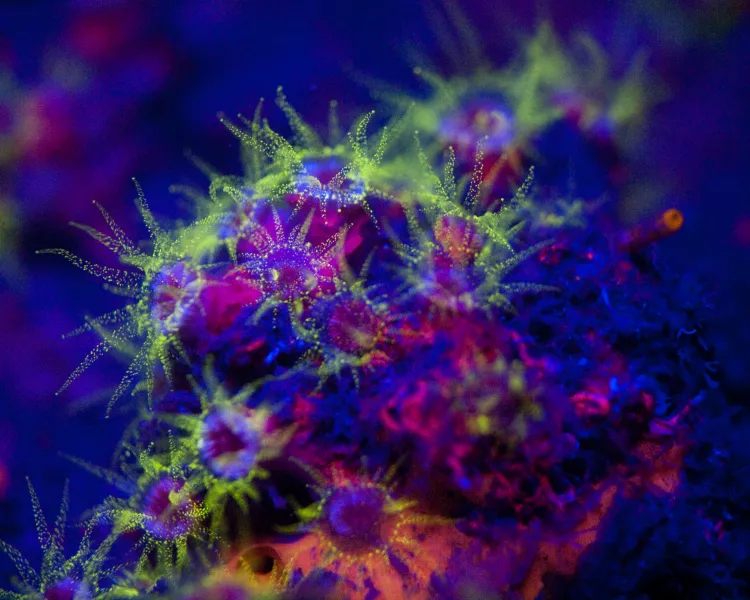
Fluorescence and Translucence
Text and photos by Larry Cohen
While diving in Costa Brava, Spain, I decided to try fluorescence photography. Some marine life emits light at a lower wavelength that is invisible to the human eye. This is known as fluorescence. To observe fluorescence, you need to work in the dark and use a blue light that will act as an excitation source. You must also have a yellow barrier filter over your lens and eyes. On this dive, I had special LED lights designed to see fluorescent light, and I had barrier filter sheets that I had cut to size and put inside my macro lens port. I also taped the barrier filter to a welding mask that I wore over my dive mask.
There were many dark overhangs at Costa Brava, so I did not need to do the dive at night. I observed a sunset cup coral that was fluorescing in a variety of colors. The blue LED lights were not very bright, and the barrier filter cut out even more light. So I had to hold steady and shoot at a slow 1/15th of a second shutter speed. The resulting image captured the fluorescent colors and enhanced the sunset cup coral’s translucent appearance.
In British Columbia, Canada, there is an abundance of marine life at every dive site. One creature I saw there was the opalescent nudibranch, which has a translucent body with orange tips. On the same dive, I spotted a cleaner shrimp that took on the orange color of its surroundings because the shrimp is translucent.
While diving an unnamed shipwreck off Pom Pom Island, Malaysia, I encountered a large school of silversides. Seeing so many of these tiny translucent fish made the wreck come alive with brilliance and movement. Visit: liquidimages.com
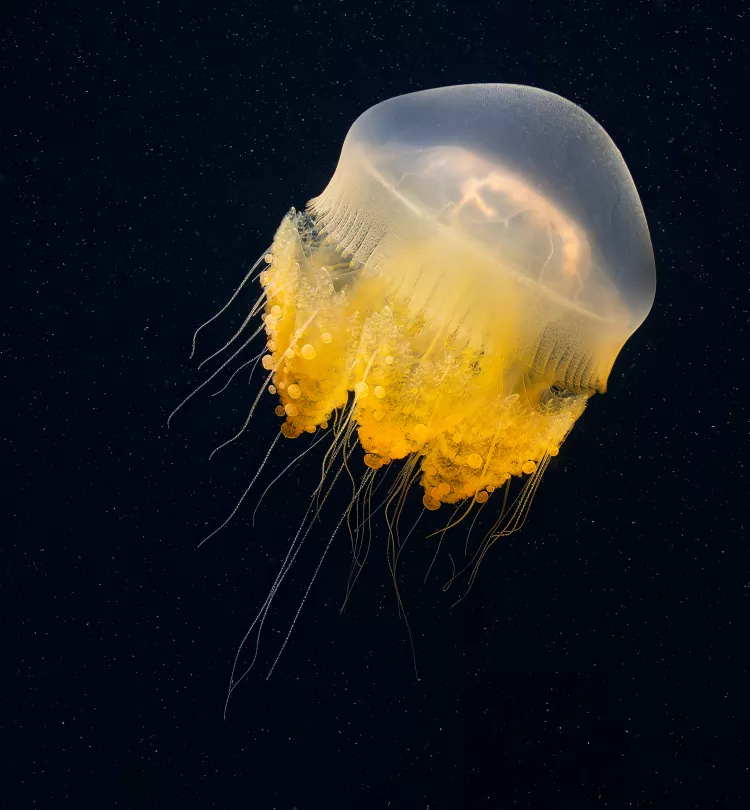
Jellyfish, Tunicates and Shrimp
Text and photos by Anita George-Ares, PhD
The tomato jellyfish in Photo 1 has a translucent bell. The image reminds me of a spaceship traveling against a backdrop of distant stars. Adult tomato jellyfish are typically red. The yellow color of this individual may reflect differences between juveniles and adults or may be a variation within the species. While diving in Raja Ampat, I came upon a hawksbill sea turtle near the surface eating tomato jellyfish.
The blue bell tunicates in Photo 2 are translucent. The blue club tunicates in Photo 3 are also translucent except for their transparent siphons. Other tunicate species can be completely transparent or opaque. Tunicates come in a variety of forms and colors and can be solitary or colonial. I enjoy photographing tunicates and find them interesting, especially since tunicates play an important role in medical research and drug screening (Dumollard et al., 2017).
A partially transparent magnificent anemone shrimp rests on an anemone in Photo 4. This cleaner shrimp species is common in the western Pacific and resides on both anemones and hard corals. Visit: facebook.com/profile.php?id=100016947967639
Reference: Dumollard R, et al. 2017. Ascidians: An emerging marine model for drug discovery and screening. Curr top med chem 17(18) 2056-2066. https://pubmed.ncbi.nlm.nih.gov/28137240/
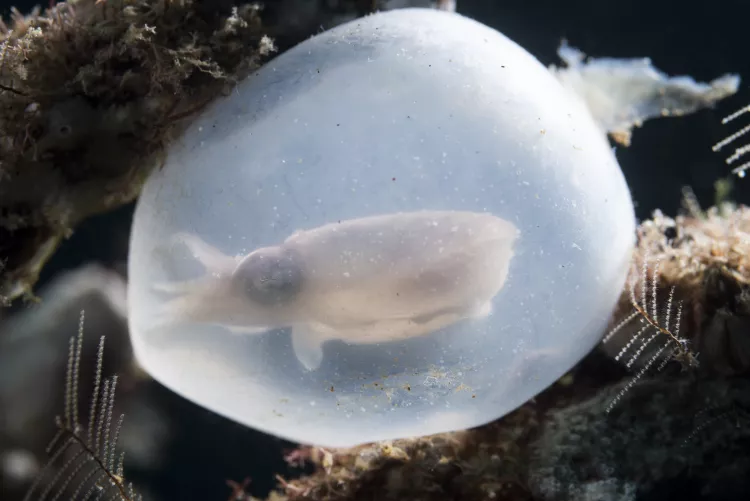
Egg Casings
Text and photos by Matthew Meier
Egg casings are one of the more prevalent examples of transparency in the underwater world. Multiple species of cephalopods and fish lay clear eggs that allow us voyeurs to observe and document the development of their young. On several occasions, I have been fortunate enough to witness baby squid and cuttlefish break through their protective cocoons and emerge for the first time into their new ocean home. Flamboyant cuttlefish are notorious for placing their eggs on the underside of discarded coconut husks, so I always look underneath when on a muck dive. Just remember to flip the husk back over so that predators cannot get to the eggs.
Photographing a shiny, spherical object can be a challenge. I highly recommend using side lighting, or even back lighting, if possible, to best illuminate the contents of the egg while minimizing any distracting glare or reflections from the lights. Cameras can also struggle to focus on the subject through the egg casing, so it may be best to lock focus on a nearby object at the same distance and then recompose. Clownfish are very protective of their eggs and will not be happy with your intrusion, so do your best to get in and out quickly, so as not to stress out the parents. Visit: MathewMeierPhoto.com
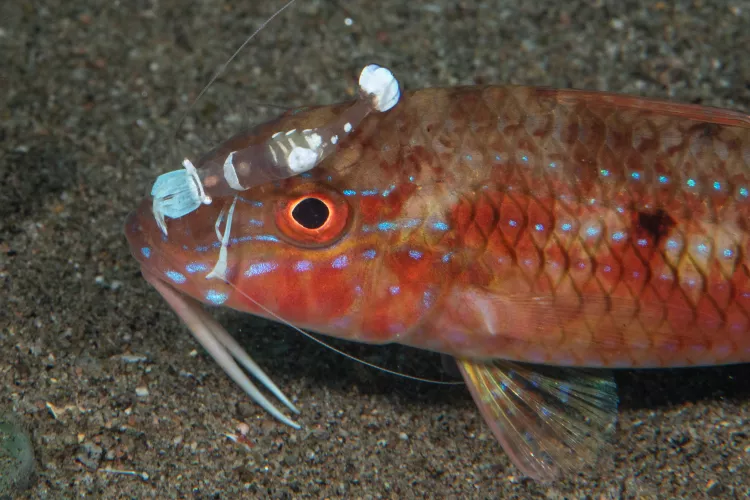
Cleaner Shrimp
Text and photos by Brandi Mueller
On a recent trip to the Philippines, I was thrilled to find cleaning behavior almost everywhere I looked. It is one of my favorite behaviors to observe underwater. I loved watching the mostly transparent shrimp crawl all over various fish to pick them clean of parasites and dead skin. The act is mutualism at its finest. The fish get a bath and spa treatment and the shrimp get a meal (plus, they don’t become a meal).
Most of the shrimp were very tiny, but a few were quite large, including one that was almost as big as the head of the goatfish it was cleaning. One pufferfish looked like it was lying down in the sand and was covered with at least eight see-through shrimp. The fish were being cleaned all over, from the inside of their mouths to their gills and all over their bodies. It is nice that the shrimp can get to those hard-to-reach places! Visit: brandiunderwater.com
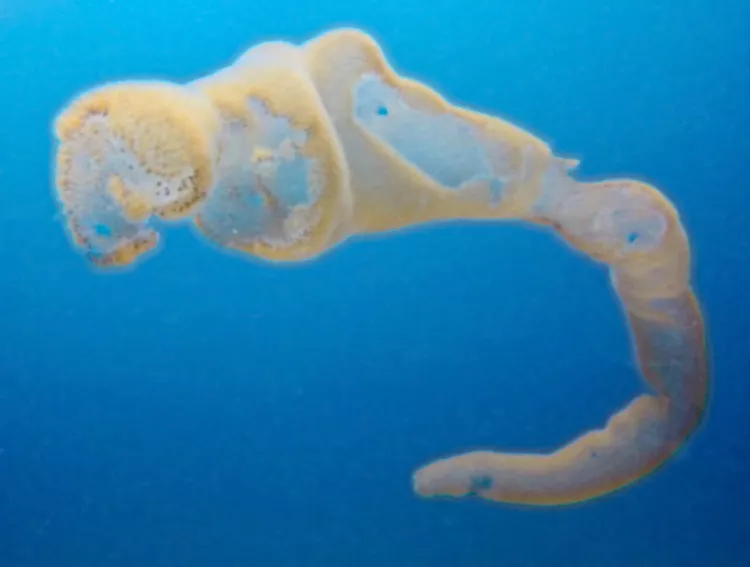
Invertebrates and Chordates
Text and photos by Gary Rose, MD
Little did I realize in my college days, as I was falling asleep in Biology 101, that the lecture topics of invertebrates (with no spinal cord) and chordates (with at least a stiff supporting rod) would one day become very relevant in my diving world. Now, when I come across these fascinating creatures, I enjoy watching the confused looks on the faces of my fellow divers as they observe these captivating creatures in the water column.
Photo 1 is of a four-foot-long pyrosome, a tunicate (chordate) that is a cylindrical colony made up of thousands of individual zooids. Pyrosomes are transparent, gelatinous, and float, writhe and dance close to the surface of the sea. As they drift with the prevailing currents, they catch phytoplankton in a self-created mucus net and feed on them. At night they are bioluminescent. I have seen only a few pyrosomes in my many years of diving. Their large size and mystery create a very lasting impression.
In contrast, Photos 2a and 2b are of a much smaller larvacean (chordate), also a transparent tunicate. This one was about five inches long. The central part looks like a tadpole. The larger outer parts are self-created gelatinous wings with which the larvacean captures and eats tiny particles and debris that sink in the water column. They are hard to find. It helps to be near the surface, have good visibility and bright sunlight. Shooting upwards and at an angle allows light to both transmit through and reflect off the surface of a larvacean, enhancing the ability to take very creative photographs. By playing with the ambient light and patiently adjusting your settings, you can capture the central larvacean and the delicate mucus wings.
Every time that I see a bottle, can or pipe lying in shallow water, I look inside and closely inspect it. There are all types of surprises to be found. Many wonderful creatures take refuge and hide in these man-made objects. I like to use a very low intensity dive light to help with my investigation. Photo 3 was the reward for such an investigation. This beautiful “octomom” was protecting her bead curtain of eggs. It is easy to see the tiny, almost fully formed octopi inside the individual transparent eggs.
This was one of the most technically difficult photos that I have ever taken. The 14-inch segment of pipe protruding from the sand was pointing straight up. The diameter of the pipe was just large enough for my camera lens to slightly overlap. Forced to handhold my strobe remotely, above and just off to the side, I shot a series of photos—all the while being careful not to burn Octomom’s eyes or the eggs. Each photo was taken blindly and was dependent on my pre-shoot setup. The strong ebbing tide in shallow water added another level of difficulty. The octopus is an invertebrate and not a chordate.
The first time that I encountered a huge invertebrate chordate was in a cave in the British Virgin Islands. It was about eight feet long, amorphous and, frankly, quite scary. I was a relatively new diver and had no idea what it was, but I was fascinated by it. I saw my dive guide’s terrified face and was unfortunately forced by the guide to abandon my investigation of one of nature’s marvels. As humans, we are often afraid of the unknown and that which we do not understand. As we explore the sea with our cameras, we will find many new and fascinating creatures. Visit: garyrosephotos.com
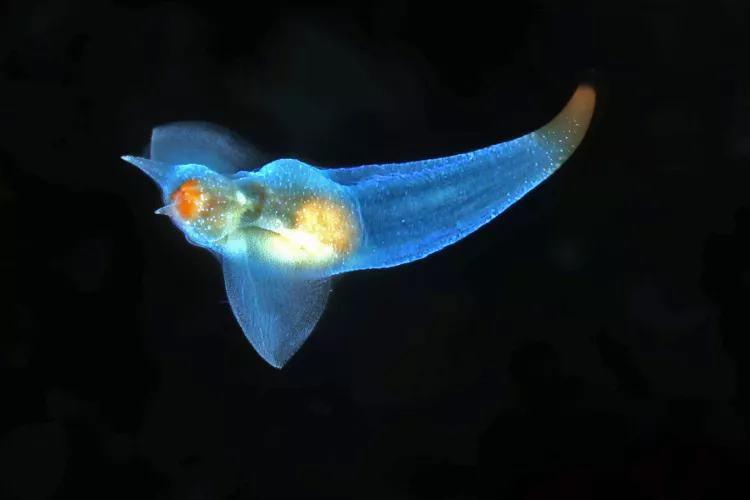
Angels, Nettles, Larvae and Stars
Text and photos by Michael Rothschild, MD
Light is to the photographer what stone is to the sculptor. We focus it and bounce it. We add it and remove it. And ultimately, we use the light reflected back from our subjects to create our images.
But some subjects do more than just reflect the light—ambient or artificial—that we guide towards them. Some of the living organisms of the deep can absorb and filter light, passing it through their bodies, with evolutionary benefits for both predator and prey. What better way to camouflage yourself than to let the background show through your body?
Photo 1 is of a sea angel—a free-swimming slug—floating in the shallow water over a shipwreck near New York City. Photo 2 is of an Atlantic sea nettle jellyfish, also over one of the local wrecks. Photo 3 is of a northern star coral, with its sticky translucent fingers always filtering the water for food. Finally, Photo 4 shows the larval stage of a flounder, whose body has yet to turn into a flatfish, with its eyes migrating to the topside. Visit: dive.rothschilddesign.com
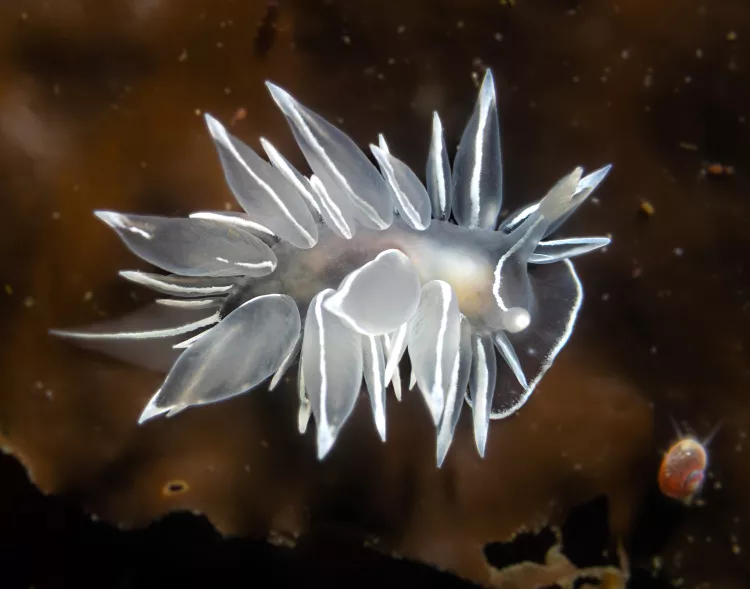
Nudibranchs and Salps
Text and photos by Olga Torrey
The white-lined dirona (Dirona albolineata) is also known as the alabaster nudibranch, frosted nudibranch, or chalk-lined dirona because of its snow-white color. It has a translucent body and there is a white outline on each of its cerata and on its tail. This sea slug is carnivorous and preys on bryozoans, snails, hydroids and ascidians.
The hooded nudibranch Melibe leonina is found on seagrass and kelp. It is clear in color and has wispy tentacles and a round hood. This nudibranch looks like a jellyfish and is most often seen swimming at night, using a fruity scent to ward off predators. It is carnivorous and eats crustaceans, ostracods, amphipods, larvae and copepods, swallowing its prey whole.
The pelagic tunicate or salp Salpa aspera spends most of its time in deeper waters during the day. Its gelatinous, barrel-shaped body is translucent and colorless with a hint of pale green or yellow. It has dorsal nerve cords and moves by propulsion, which helps to pump water through its internal feeding filters. Salpa aspera is a tubular, transparent, gelatinous animal that feeds on phytoplankton. It resembles a jellyfish in body shape and is planktonic, drifting passively with the current. Small fish can sometimes be seen swimming inside it to protect themselves from predators. Visit: fitimage.nyc
Source: Wikipedia.org

